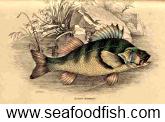THE BOSTON COOKING-SCHOOL COOK BOOK
By Fannie Merritt Farmer (Boston, 1896)
LOBSTER
To Select a Lobster.
Take in the hand, and if heavy in proportion to its size, the lobster is fresh. Straighten the tail, and if it springs into place the lobster was alive (as it should have been) when put into the pot for boiling. There is greater shrinkage in lobsters than in any other fish.
To Open Lobsters.
Take off large claws, small claws, and separate tail from body. Tail meat may sometimes be drawn out whole with a fork; more often it is necessary to cut the thin shell portion (using scissors or a can-opener) in under part of the tail, then the tail meat may always be removed whole. Separate tail meat through centre, and remove the small intestinal vein which runs its entire length; although generally darker than the meat, it is sometimes found of the same color. Hold body shell firmly in left hand, and with first two fingers and thumb of right hand draw out the body, leaving in shell the stomach (known as the lady), which is not edible, and also some of the green part, the liver. The liver may be removed by shaking the shell. The sides of the body are covered with the lungs; these are always discarded. Break body through the middle and separate body bones, picking out meat that lies between them, which is some of the sweetest and tenderest to be found. Separate large claws at joints. If shells are thin, with a knife cut off a strip down the sharp edge, so that shell may be broken apart and meat removed whole. Where shell is thick, it must be broken with a mallet or hammer. Small claws are used for garnishing. The shell of body, tail, and lower part of large claws, if not broken, may be washed, dried, and used for serving of lobster meat after it has been prepared. The portions of lobsters which are not edible are lungs, stomach (lady), and intestinal vein.
CRABS
Crabs among Crustaceans are next in importance to lobsters, commercially speaking. They are about two and one-half inches long by five inches wide, and are found along the Atlantic coast from Massachusetts to Florida, and in the Gulf of Mexico. Crabs, like lobsters, change their shells. Soft-shell crabs are those which have recently shed their old shells, and the new shells have not had time to harden; these are considered by many a great luxury. Oyster crabs (very small crabs found in shells with oysters), are a delicacy not often indulged in. Crabs are in season during the spring and summer.
TO PREPARE FISH FOR COOKING.
To Clean a Fish.
Fish are cleaned and dressed at market as ordered, but need additional cleaning before cooking. Remove scales which have not been taken off. This is done by drawing a knife over fish, beginning at tail and working towards head, occasionally wiping knife and scales from fish. Incline knife slightly towards you to prevent scales from flying. The largest number of scales will be found on the flank. Wipe thoroughly inside and out with cloth wrung out of cold water, removing any clotted blood which may be found adhering to backbone.
Head and tail may or may not be removed, according to size of fish and manner of cooking. Small fish are generally served with head and tail left on.
To Skin a Fish.
With sharp knife remove fins along the back and cut off a narrow strip of skin the entire length of back. Loosen skin on one side from bony part of gills, and being once started, if fish is fresh, it may be readily drawn off; if flesh is soft do not work too quickly, as it will be badly torn. By allowing knife to closely follow skin this may be avoided. After removing skin from one side, turn fish and skin the other side.
To Bone a Fish.
Clean and skin before boning. Beginning at the tail, run a sharp knife under flesh close to backbone, and with knife follow bone (making as clean a cut as possible) its entire length, thus accomplishing the removal of one-half the flesh; turn and remove flesh from other side. Pick out with fingers any small bones that may remain. Cod, haddock, halibut, and whitefish are easily and frequently boned; flounders and smelts, occasionally.
To Fillet Fish.
Clean, skin, and bone. A piece of fish large or small, freed from skin and bones, is known as a fillet. Halibut, cut in three-fourths inch slices, is more often cut in fillets than any kind of fish, and fillets are frequently rolled. When flounder is cut in fillets it is served under the name of fillet of sole. Sole found in English waters is much esteemed, and flounder is our nearest approach to it.
Classic Seafood Recipes & Fish Recipes
How to choose, clean, skin, bone, fillet and cook fish and other seafood
FISH INFORMATION
Eliza Acton
Catharine Beecher
Eliza Leslie
Mrs. D. A. Lincoln
Fannie Farmer
The Settlement
Please feel free to link to any pages of SeafoodFish.com from your website.
For permission to use any of this content please E-mail: james@seafoodfish.com
Original material copyright © 1990 - 2017 James T. Ehler unless otherwise noted.
All rights reserved. You may copy and use portions of this website for non-commercial, personal use only.
Any other use of these materials without prior written authorization is not very nice and violates the copyright.
Please take the time to request permission.

